
Until 1866, the route between New Zealand and Great Britain was via Australia. Then, between 1866 and 1868, the standard route was via Panama. That route ceased in December 1868 and, as the route via San Francisco did not open until 1870, the only route was via Australia in 1869-70.
Several of the covers on this page are shown in [4]. A House of Commons Report published in 1850 showing rates of postage and other details for mail between UK and New Zealand and New South Wales in the three years to January 1848 has been reproduced in [5].
The topic of this page is continued with first sideface covers being shown at 1874 First Side-Face Covers and second sideface covers at Second Side-Face Covers.
Ship Mail from Australia to New Zealand, 1844
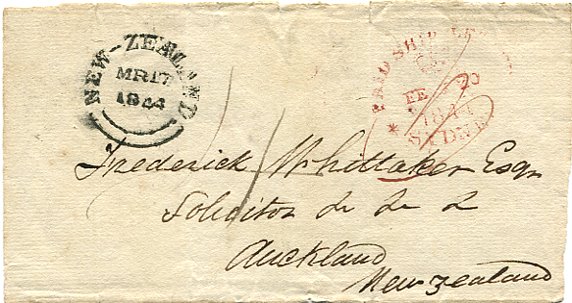
This is the front of an entire that was sent by Ship Mail from Sydney to Auckland in 1844. It has a Paid Ship Letter Sydney handstamp in red manuscript dated 20 February 1844 together with a 3 in red indicating how much had been paid.
There is a New Zealand receiving mark in black dated 17 March 1844 together with a 4 in black manuscript indicating how much had to be paid on receipt. According to [2], this date stamp was used in Auckland from 1844.
From 1 March 1842, the postage rate for delivery of a a letter from a post office within New Zealand was 6d and this was reduced to 4d on 6 September 1843 which explains the black manuscript 4 [1].
There was no organised mail service between Australia
and New Zealand until 1858; mail was carried by ship's
captains as ship letters.
Advertising Sailing Ship to New Zealand, 1851

This advert is part of a folded entire from London to a merchant in Glasgow in February 1851. It is advertising the first ship, the Norfolk, that was to sail from the UK direct to Auckland, New Plymouth and Nelson.
It states that it was to leave punctually on 5 March, but apparently the Norfolk did not actually sail until 17 March. It carried 8 passengers and arrived in Auckland on 16 August and in Nelson on 21 September. There does not seem to be any record of it going to New Plymouth.
It would be interesting to find out if any letters were carried on the voyage.
via Australia (1852-1854)
The first steamship mail contracts between the UK and Australia were awarded in 1852. There were two different routes: from June 1852 until early 1854 the Australian Royal Mail Steam Navigation Company (ARM) sailed via the Cape of Good Hope while from late 1852 until 1854, P&O provided an extension of their service via Egypt to Singapore. Each service was bi-monthly giving an overall monthly service.
Although there were services before then, the first contract described in [1] for a service between New Zealand and Australia was in 1858 and was for a monthly service between Auckland and Sydney. It should be noted that the European population of New Zealand was very small at this stage; in 1851 it was 26,707.
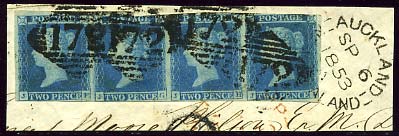
This strip of four British 1841 twopenny blues has an Irish postmark and an Auckland receiving datestamp of 6 September 1853. (The ship letter rate at that time was 8d.) The ARM ship Victoria left London on 19 June and arrived in Sydney on 28 August and so may have carried this letter.
This Auckland datestamp was first used in 1847. It has the letter A below the date. According to [3], the letters A, B and C were used from the mid 1850's to indicate the different mails within each day.
From 1851 until 1857, senders of letters from New Zealand to the UK could only pay for the local postage cost (twopence) while the receiver had to pay for the cost (eightpence) from New Zealand to Great Britain. The amount paid in New Zealand was written in red ink while the cost to the recipient was written in black ink.
via Australia (1857-1859)

The European and Australian Royal Mail Company carried mail between UK and Australia via Galle (Ceylon) and Suez with the first sailing leaving Southampton in February 1857 and the last in February 1859.
This letter is franked with a strip of three 2d Chalons as the 6d Chalon was not issued until August 1859. It is franked with the obliterator labelled 18 which was used at Dunedin.
It was carried on the Victoria that left Sydney on 11 October 1858.
As the Victoria was leaking, mail was transferred at Galle on 13 November
to the Oneida which then broke her screw and had to
proceed to Aden by sail.
From Aden, the mail was taken by P&O to Suez arriving on 5 December.
The mail then left Alexandria on 7 December and arrived in Southampton on
18 December.
It has a London receiving mark of 20 December 1858.
via Australia and Mauritius (1859-1860)
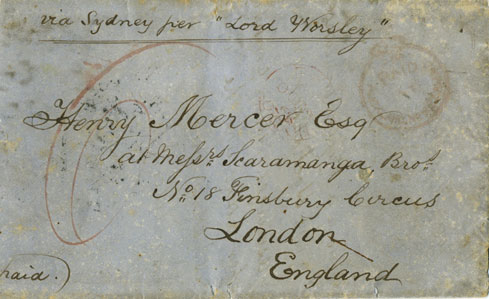
From 1859, P & O held the Australia - UK (Sydney - Southampton) contract. The route was initially via Melbourne, Mauritius and Aden to Suez. Mail was then carried overland to Alexandria and from there to Southampton via Malta and Gibralter. The postal rate to the UK was 6d per ½oz.
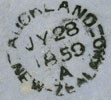
This stampless entire has a large manuscript 6 in red indicating that the postal rate to the UK had been prepaid. There is also a faded Auckland Paid Crown Cancel and a faint London paid transit mark dated OCT on the front. On the back, there is an 28 July 1859 Auckland datestamp.
Details of the New Zealand - Australia service are given in the next section.
The likely route and dates of this letter from New Zealand to the UK are:
- Left Auckland 28 July, arrived Sydney 5 August,
- Left Sydney 15 August on the P&O steamer Salsette, arrived Port Louis (Mauritius) 9 September and Suez on 25 September
- Overland Suez to Alexandria,
- Left Alexandria 30 September on the Indus, arrived Southampton 14 October.
to UK via Australia and Ceylon (1860-1866)
From 1860, the P & O route was changed with Mauritius being replaced by Galle in Ceylon.
Changes in the New Zealand - Australia service
The route and the contractor for the New Zealand - Australia service changed several times.
1859 Service
From April 1859, the Inter-Colonial Royal Mail Company had the contract for two sailings each month from Sydney: one to Auckland and the other to Nelson, Wellington, Lyttleton (Canterbury) and Port Chalmers (Dunedin). In addition, there was a domestic service linking Auckland and Port Chalmers.
Although the Queen Victoria Chalon Heads had been introduced in 1855, it was possible to prepay postage in cash until 1862.
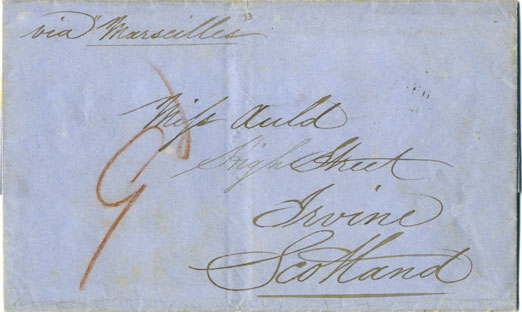
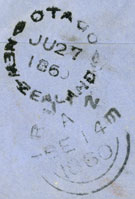
This stampless entire was sent from Otago to Irvine in Scotland in 1860. There is a large 9d in red ink on the front of the letter to indicate the amount that had been paid.
It has an Otago datestamp of 27 June 1860 on the back and would be carried by steamer from Port Chalmers on 27 June arriving in Sydney on 12 July. The route from Sydney to Suez was now via Galle in Ceylon instead of being via Mauritius. The letter left Sydney on 22 July on the Ottawa, arriving in Galle on 16 August and Suez on 4 September.
Since March 1857, mail could be speeded up by several days by marking it via Marseilles. This cover left Alexandria on 5 September on the Massilla arriving in Marseilles on the 11th. It was taken through France by rail, arrived in London on 12 September and has a 14 September receiving mark in Irvine and so was 80 days in transit.
The Marseilles route had an extra charge of 3d per quarter oz in addition to the normal 6d per ½oz. which is why the postage was 9d.
1863 Services
There were several alternative services between New Zealand and Australia in 1863; either between Auckland and Sydney or between Port Chalmers and Melbourne.
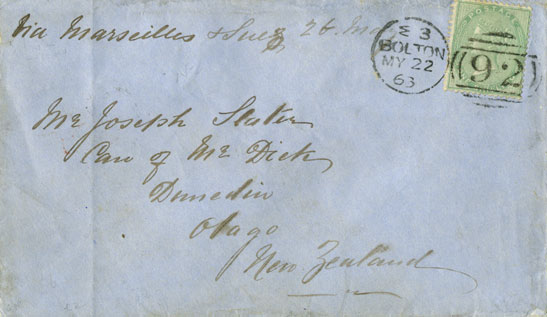

This cover is postmarked in Bolton on 22 May 1863 and has a red London transit mark on 23 May. The mail for Australia had left Southampton on 20 May. However, this cover is routed via Marseilles and so was carried to France and railed to Marseilles.
The mail left Marseilles on 28 May and arrived in Alexandria on 3 June. After leaving Suez on 4 June, the mail arrived in Melbourne on 14 July and Sydney on 16 July. The cover has a Dunedin receiving mark of 23 July and so must have been shipped directly from Melbourne to Port Chalmers. It was in transit for 63 days.
From September 1863, there was a composite rate on the Marseilles route of 10d per ½oz. The use of the Marseilles route ended in September 1870.
Ship letter, Sydney 1864

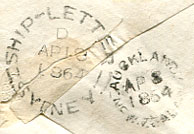
This cover is postmarked in Auckland on 8 April 1864 and has a Sydney Ship Letter mark on 18 April.
The cover is postmarked with an imperforate 6d Chalon. From 1 January 1859, all letters sent abroad from New Zealand had to be prepaid at a rate of 6d per ½ oz [1].
That rate remained until 1 April 1870 when it was reduced to 3d.
McMeckan and Blackwood service 1864-65
From 11 January 1864 until 10 September 1865, McMeckan and Blackwood of Melbourne had a contract to carry the New Zealand mail from Port Chalmers (Dunedin) in Otago to Melbourne where it joined the Australia - UK P & O service [1].


However, that was not the only service. This cover is postmarked Auckland on 17 June 1865. According to the Daily Southern Cross for 1 July 1865, the English mails left Auckland on 1 July on the Prince Alfred [7].
That would connect with the Salsette which left Sydney on 22 July and connected with the Bengal in Ceylon on 19 August which then arrived in Suez on 5 September. The Ceylon left Alexandria on 7 September and arrived in Southampton on 21 September.
The cover was then backstamped in Cockermouth on 22 September and
so was in transit for 93 days.
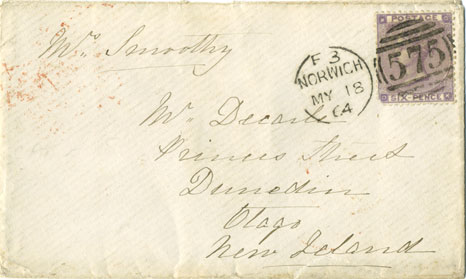


This next cover is from the UK and is addressed to Dunedin. It is postmarked in Norwich on 18 May 1864 and has a London transit mark on 19 May. The Ceylon left Southampton on 20 May and arrived in Alexandria on 4 June. The Golconda left Suez on 6 June and arrived in Melbourne on 13 July.
The cover would then be carried by the McMeckan and Blackwood service from Melbourne to Port Chalmers (the port for Dunedin). It has a faint Dunedin backstamp in July, but the exact date is unclear, but could be 23 July.
The contract was for the steamer to leave Melbourne within 24 hours of
the arrival of the mail from the UK and for the mail to be delivered in Port Chalmers
within 6 days 12 hours after that.
The expected arrival time in Dunedin was therefore the expected arrival date
was 21 July.
Otago Steam Ship Company service 1865-68
From 10 September 1865 until September 1868, the Otago Steam Ship Company had the Port Chalmers - Melbourne contract.
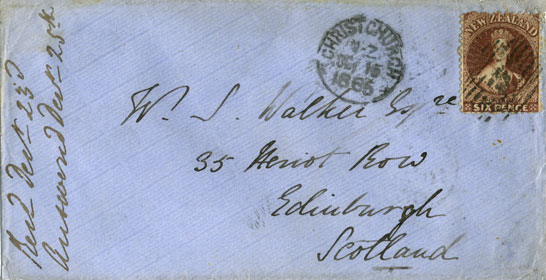

This cover is postmarked Christchurch on 15 October 1865 and was carried from Lyttleton to Port Chalmers on 16 - 17 October by the Inter-Colonial Royal Mail Company.
That connected with the Port Chalmers - Melbourne service on 18 October. The mail then left Melbourne on 26 October and arrived in Suez on 4 December. It then left Alexandria on 7 December and arrived in Southampton on 22 December.
It is backstamped Edinburgh on 23 December and so was in transit
for 69 days.
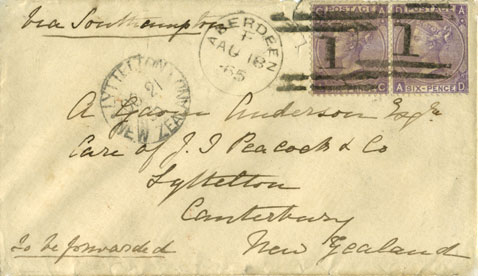
The next cover was sent from Scotland to New Zealand. The manuscript routing instruction is via Southampton.

It is postmarked 18 August 1865 in Aberdeen and backstamped in red in London on 19 August. The ship left Southampton on 20 August and arrived in Alexandria on 2 September. It then left Suez on 7 September and arrived in Melbourne on 11 October where it connected with the steamer to Port Chalmers in New Zealand.
It was then shipped from Port Chalmers to Lyttleton on 20 - 21 October. There is a receiving mark on the front at Lyttleton (Christchurch) on 21 October showing that it was in transit for 65 days.
As the postal rate was 6d per ½oz. and the cover has two 6d
stamps, it must have been overweight.
via Panama 1866-1868
Between 24 June 1866 and 8 December 1868, this was the standard route between New Zealand and the UK [6].
Mail services required a Government subsidy and, as the British Government was unwilling to set up a trans-Pacific route, the New South Wales and New Zealand colonies set up and subsidised a new route from Sydney via Wellington to Panama which was run by the Panama, New Zealand and Australian Royal Mail Co.
From Panama, the mail was sent by rail to Colon on the Caribbean Coast (the Canal did not open until 1920) and from there by the existing West India Mail Packet via Jamaica to the UK.
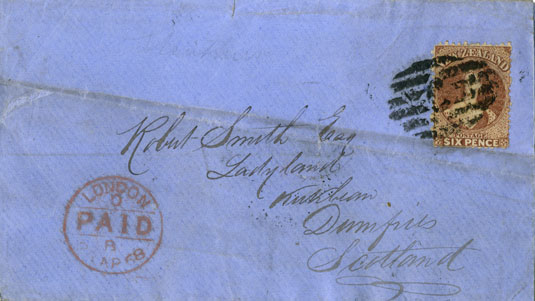
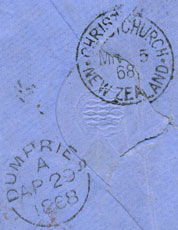
This (rather creased) cover is postmarked 5 March 1868 in Christchurch and is addressed to Dumfries in Scotland.
The mail left Wellington on 8 March and arrived in Panama on 3 April. It left Colon on 5 April and arrived in Plymouth on 28 April.
The cover has a red London PAID mark on the front
dated 28 April 1868 and the backstamp shows that it arrived in
Dumfries on April 29.
It was therefore 55 days in transit.

The next cover was sent to New Zealand via Panama in 1868.
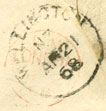
It has an indistinct red London transit mark and a Wellington receiving mark on 21 April 1868. That is the arrival date of the mail that left Southampton on 2 March.
Due to an outbreak of yellow fever, passenger numbers fell
and New Zealand could no longer afford the subsidy.
The service was therefore terminated with the last sailing from
Wellington being 8 December 1868 and the last sailing from
Southampton being 2 January 1869.
Unusual 5 handstamp in red


This cover does not have routing instructions, but is backstamped in London on 19 January 1867.
The next sailing via Panama was not until 2 February and so it could have been carried on the Pera which left Southampton on 20 January and arrived in Alexandria on 3 February. The Simla left Suez on 4 February and arrived in Galle on 20 February. The Avoca left Galle on 20 February and arrived in Melbourne on 16 March and Sydney on 19 March. It would then have arrived in New Zealand in late March.
However, the cover has a Wellington backstamp on 11 April and a Christchurch backstamp on 12 April. The Wellington arrival date corresponds to the sailing that left Southampton on 2 February and left Panama on 27 February. It was therefore carried via Panama even though that meant that it arrived later in New Zealand than the mail via Suez.
An interesting feature is the large red 5 handstamp.
In covers sent in the 1850s, this would indicate the amount which went to
the UK authorities who were providing the service, but I cannot find any information about its use
in 1867.
There also seems to be no need for it as the cover has the correct franking of 6d.
Reversion to route via Suez 1869-1870
The route via Panama ceased in December 1868 and the route via San Francisco did not open until 2 April 1870. Between these two dates, the standard route was again by P&O via Suez.
The Melbourne - Port Chalmers service operated by the Otago Steam Ship Company had been terminated in September 1868 due to the success of the Panama route. An Auckland - Sydney service by the Panama, New Zealand and Australian Royal Mail Co. was to start in January 1869, but it is not clear if that occurred as that company went out of business following the end of their route via Panama.


A new Melbourne - Port Chalmers service by McMeckan and Blackwood started in April 1869.
This cover from Napier is postmarked in May 1969 and backstamped 17 July in Penzance in England. It is likely to have been first taken by coastal steamer to Port Chalmers and from there by the McMeckan and Blackwood service to Melbourne.
It left Melbourne on 24 May on the Geelong and arrived
in Galle on 14 June.
It was transferred to the Surat, leaving Galle on 15 June and arriving
in Suez on 1 July.
It was then carried on the Delhi, leaving Alexandria on 3 July
and arriving in Southampton on 15 July.


The next cover is postmarked 14 May 1869 in Glasgow and has via Suez in manuscript. There is an indistinct London transit mark on the back.
The mail left Southampton on 15 May and arrived in Alexandria on 28 May. It left Suez on 30 May and arrived in Melbourne on 6 July.
It would then have been carried by the McMeckan and Blackwood service from Melbourne to Port Chalmers. The cover is backstamped on 17 July in Dunedin and so was 65 days in transit.
The Suez Canal opened in November 1869, but was not used
for mail until 1874.
Route via San Francisco 1870 - 1873
The trans-continental railway between San Francisco and New York opened in May 1869. In 1870, the Australian Steam Navigation Company started a route Sydney - Auckland - Honolulu. Mail was then carried from Honolulu to San Francisco.
This was replaced in May 1871 by a mail contract with the California, New Zealand and Australian Mail Line, also known as Webb and Holladay. This was a monthly service. Initially the route was Port Chalmers - Lyttleton - Wellington - Auckland - Honolulu - San Francisco, but from October the steamers sailed from Sydney to Auckland.
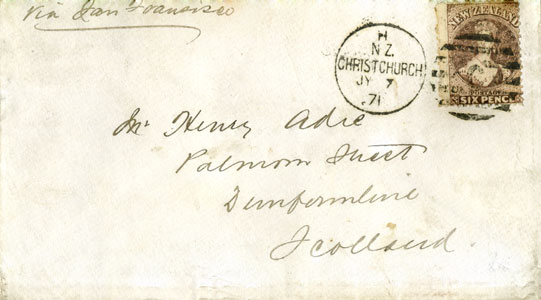

This cover to Scotland is postmarked 7 July, 1871 at Christchurch and so would start its journey at Lyttleton. The mail then left Auckand on 13 July and arrived in San Francisco on 13 August.
It then left New York on 22 August on a Hamburg - America steamer and arrived in Plymouth on 2 September. Many companies operated a trans-Atlantic service and mail went by the next convenient steamer. The cover was backstamped in Dunfermine on 4 September.
Webb and Holladay ended the contract without warning in 1873. The last despatch of mail from London was on 6 February, although the service continued longer in the other direction with the last sailings from Auckland being on 20 March and 21 April.
Reversion to route via Suez 1873

With the end of the Webb and Holladay contract, the only route between New Zealand and the UK was again via Suez.
This cover is postmarked at Christchurch on 19 March 1873 and so could have been sent on the last Webb and Holladay sailing.
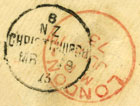
However, it has routing instructions via Suez and so went via Australia. It left Melbourne on the Sumatra on 22 April, arriving in Galle on 13 May and Suez on 31 May. It was then carried on the Simla, leaving Alexandria on 2 June and arriving in Southampton on 14 June. It has a London receiving mark dated 14 June.
From December 1873, the route via San Francisco was re-opened with the Sydney - Auckland -
San Francisco service being operated by The Australasian and American Mail
Steamship Co , but this service ceased in late 1875.
The service was then operated by
The Pacific Mail Steamship Company
The above information is taken from:
[1] Australia New Zealand UK Mails to 1880: Rates Routes and
Ships Out and Home, Colin Tabeart, Fareham, 2004.
[2] The Postage Stamps of New Zealand Vol 3, published by the
Royal Philatelic Society of New Zealand in 1955.
[3] The Postage Stamps of New Zealand Vol 7, published by the
Royal Philatelic Society of New Zealand in 1988.
[4] Robert Clark, New Zealand classics: early postal history and postage stamps,
Stamp & Coin Mart, pp 32-35, October 2008.
[5] John Campbell, Colonial Postage 1848, The Mail Coach, 33(6), 128-130,
August 1997.
[6] John Woolfe, New Zealand Mail to UK via Panama, The Mail Coach, 35(2), 35-39,
December 1998.
[7] Papers Past,
available at: paperspast.natlib.govt.nz/cgi-bin/paperspast
All scans were made by the author.